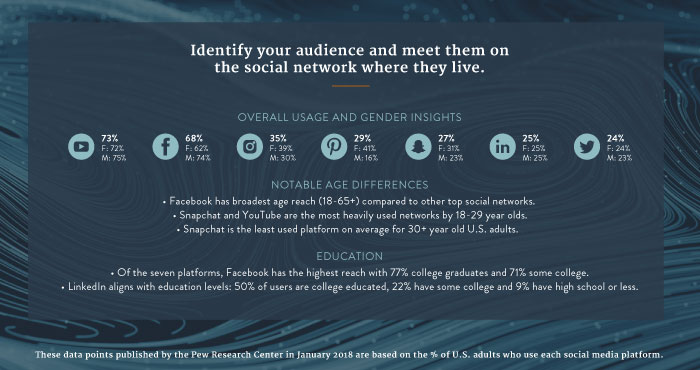When it comes to social media, the big question in boardrooms today isn’t whether or not to go social, but how to reach the right audience on the right platform. Approximately 2 billion internet users are using social networks and these figures are still growing as mobile device usage and mobile social apps are increasingly adopted by consumers. With a number so large and a multitude of networks spanning Facebook to Pinterest to WhatsApp to LinkedIn and more, your target audience is somewhere in the count. So how do you engage when you also need to balance employee resources, budgets and time.
To help answer this question, your brand should be at the center of a process that explores and balances the needs of the audience and the social network channels. At Intrinzic, our brand synchronization process helps brands find their distinct marketing channel universe — whether that be owned, paid, earned or shared — within the complex world of media options.
Let’s explore the basic process.
1 Identify Your Audience
Understanding your audience and what they need and desire from your brand is the first step in determining which social channel you should play. You need to dig deeper to understand the expectations, desires and dreams of the audiences. This exercise goes beyond the “who” and gets to the “what” and “why” they are looking for from the brand and channel. For example, when partnering with a finance client, we would identify the needs of someone looking to invest through the lens of what service they ultimately need—such as integrated wealth management services—and pair that with the higher level purpose of the client’s brand: giving their clients the financial peace of mind to focus on the things that really matter, their desires and dreams. You want to be as specific as possible so you can determine the times they think about these services (needs) or desires and then pair them with the channels they use to help them address their particular situation.
Audience prioritization is important at this step, too. With limited resources, you’ll want to assess channels that sweep the strongest cross-section of your audience and make the biggest impact in driving the bottom line.
2 Analyze the Channels
Most social media channels offer a wealth of audience insights to help you determine channel demographics and if your audience is utilizing during times of need. Do your homework not only on demographics, behaviors and interests of your target audience, but also look at what competitors are doing as well as pull inspiration from outside your industry.
Once you’ve identified which social network will best reach your audience, make sure you’re following the channel’s best practices. This will begin to come naturally if you truly commit to immersing your brand in the community of the network and embrace new trends that you see gaining traction. And don’t just think static posts for broad-based advertising or engagement — video is the most popular type of content in 2018, according to Buffer Social. Buzzsumo’s research on 880 million Facebook posts in 2017 found that video posts have the highest average engagement and twice the level of engagement of other post types. See more tips from my colleague’s latest post.

Also, consider using social media as a key tool in your Customer Service toolbox. On Facebook Messenger alone, there are more than 100,000 chatbots in use, gathering information for brands, giving product guidance and taking actual orders. In fact, chatbots on Facebook Messenger have been shown to increase organizational productivity by up to 3.5 times. Facebook (https://messenger.fb.com) reports 53% of people are more likely to shop with a business they can message and 56% of people would rather message than call customer service.
3 Brand Synchronization
Once you’ve determined your key audiences and the best channels for engaging with them, next you need to nail the message.
Make sure your message is true to your brand—not just what you think it should be for the channel. Find ways to inject your brand’s true personality and determine if a niche audience message is essential for the campaign or initiative. Be wary of trying too hard to be trendy or humorous with language if that doesn’t align with your brand attributes.
Remember, people are smart and pick-up quickly if you’re not being genuine. Social networks can become a dangerous playground if you are not true to your core brand attributes, since negative commentary can propagate exponentially and cause unintended harm to your brand. I recommend setting content pillars to help you stay focused and keep all parties (internal and agency) on the same page.
4 Measure and Optimize
Once you’ve determined your social media objective (e.g., awareness, engagement, conversion, etc.), make sure you choose the right metrics to measure performance so you can continue to optimize your strategy and message. Look beyond “vanity” metrics such as likes, followers and shares, and explore deeper metrics such as cost per acquisition, social sentiment and audience targeting delivery.
Is your social media strategy working for you? At Intrinzic we can help you ensure your audience, social channels and brand are in perfect sync. Let’s collaborate.
Discover More
[Social Media Fact Sheet, Pew Research Center](http://www.pewinternet.org/fact-sheet/social-media/)
[5 Trends That Will Shape Social Media in 2018](http://www.adweek.com/digital/penny-wilson-hootsuite-guest-post-5-trends-that-will-shape-social-media-in-2018/)
[6 Social Media Trends That Will Take Over 2018](https://sproutsocial.com/insights/social-media-trends/#infographic)
[2018 Social Media Trends Report: 10 Key Insights Into the Present and Future of Social Media, Buffer Social](https://blog.bufferapp.com/social-media-trends-2018)
Photo by NordWood Themes on Unsplash

